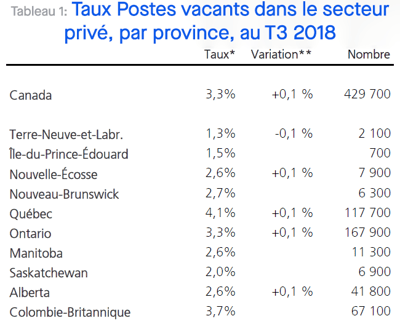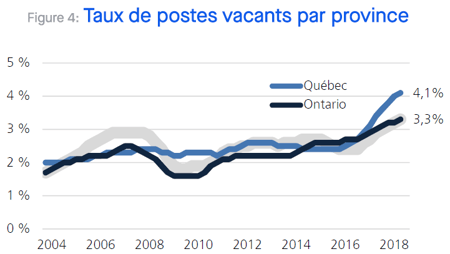The Importance of a Daily Management System in Mobilizing Employees
The industrial sector in Québec is facing quite a few challenges, among which, labour shortages stand out. In such a context, the retention of resources and their mobilization proves to be crucial to ensure regular and continuous business activities. It is at that stage that the continuous improvement of operations contributes to solving those issues using tools such as a daily management system or DMS, tools that are integrated and that promote employee engagement, performance improvement and employee retention.
Let’s look into how daily management can contribute to employee mobilization and retention.
The Issue: Labour Shortage
What was anticipated for decades is finally happening, Québec is faced with a major shortage in manpower. In its December 2018 report, the Canadian Federation of Independent Business (CFIB) states that the number of available positions increased from 2% to 4.1% in Québec.

Table 1: Vacant Positions Rate in the Private Sector, by Province, Q3 2018 |

Figure 4: Vacant Positions Rate by Province
|
Source: CFIB, Economy, December 2018.
Several businesses must therefore get creative to fill vacancies. But even when positions are filled the issue is not entirely of the past as employee retention becomes crucial. As a matter of fact, the turnover rate, across all sectors in Québec, is 24.4%.
Why a good employee would leave his or her position range from reasons such as:
- An incompetent boss;
- One that micromanages everything;
- A leader who does not promote collaboration;
- Lack of corporate culture;
- Employees having trouble identifying to the corporate culture;
- Lack of pride;
- Most people want to work for a company they are proud of;
- High stress level;
- Unworkable or unknown expectations;
- Failure to clearly define or comply with pre-established roles and responsibilities contributing to increased stress level;
- Lack of fairness and respect among employees;
- Arbitrary and unfair rules generating frustration among most employees;
- Lack of autonomy;
- Employees that are not allowed to suggest nor implement improvements in their environment are less likely to be mobilized and involved in the success of the company. They will tend to do the minimum;
- Work or task that no longer makes sense;
- Employees that do not understand how their work contributes to the success of the company tend to invest less and search for a position in which they feel they are making a difference;
- Job lacking advancement opportunities;
- Nonexistent career and development plan: employees who cannot track their own evolution fail to see the relevance of progressing.
The difficulty in recruiting and retaining good employees impacts all companies. In 2018, 53% of SME’s leaders stated that they would limit their investments due to shortages in manpower. That number was 46% just a year before.
And so, how can you remedy your employees’ lack of loyalty to their jobs? Where should you start in order to mobilize them?
How do You Engage Your Employees?
There are several ways to define employee mobilization. Generally, we say employees are mobilized when they feel a sense of belonging and are proud of the work they accomplish for a company. They would also tend to seek collaboration with their co-workers and undertake new responsibilities.
Give a Sense of Accomplishment to Your Employees
The most important lever to employee mobilization is to give meaning to their work. We can make an analogy between that and a hockey game in which players would not understand the necessity to allow time to elapse during a short-handed play. It can be counter-intuitive for them to get rid of the puck. However, they must understand that their actions serve a high-level strategy: winning the game rather than to individually score points.
The same logic must be applied to any work team. For example, in cases where managers would have to ensure defined standard work is complied with, even if it means a temporary loss of productivity. Excessive control can appear to be the most effective short-term solution, but would not favour engagement and empowerment of employees. It is crucial to make a connection between the business’s strategy and employees’ daily tasks. In this example, it would be appropriate to show the impact complying with standard methods has on the level of quality and thus, on the expected growth of market shares.
The implementation of daily management charts that include performance indicators aligned on your business strategies is an effective means to engage employees. It is an effective communication tool that gives employees a sense of purpose and allows them to appreciate their own contribution to strategic aims.
Consequently, a daily management chart should include relevant performance indicators to which each employee can participate on a regular basis. A daily review of those indicators will allow everyone to understand their input to the success of the company, define improvement opportunities, as well as favour creativity and team work.
The Roles of Leaders in Mobilization
Each leader is accountable for reaching the performance indicators targets in their chart. They are also responsible for engaging their team. Performance reviews conducted using management charts are excellent mobilization levers as they allow leaders to ask questions and have their team progress. Those reviews can also allow connecting future and current actions and projects to identified performance gaps. Employees will then be able to actively get involved in the improvement of their work on a daily basis.
Daily Management System (DMS)... An Integrated Solution
In today’s context, managing a company becomes a balancing act between business imperatives and human resource management.
DMS or Daily Management System suggest a methodology that puts forth the participation of each employee to the attainment of business objectives.
Implementing performance charts allows employees to understand their contribution and see the effect of improvements, they or their colleagues suggested.
The use of standard agendas by team leaders and managers ensures managerial alignment facilitating the integration or arising of new leaders. Additionally to allowing the operationalization of roles and responsibilities, standard agendas are the perfect tool to coordinate the roles of all the leaders. Employees then feel supported by the management team.
Implementing a flexibility matrix allows employees to track and understand their progression. Training plans thus created become great tools for employee engagement.
Finally, using a problem-solving methodology promotes team work and gives managing teams several opportunities to recognize the work of their team.
The fact that simply measuring processes improve their effectiveness by approximately 25% is well documented. These statistics can greatly increase when adding management alignment and problem solving tools.
A recent client reduced the occurrence of work-related accidents (-395 days) and cost of poor quality by 50% thanks to the implementation of a daily management program. That client’s overall gross profit increased by 4% thanks to DMS.
Although these numbers are quite impressive, you must remember that a DMS is much more than just an approach that facilitates reaching business targets. It is an engaging management framework that allows for everybody to grow and contribute to the success of the company. In a labour shortage context, a DMS should be considered a balanced approach that allows combining business imperatives and sustainable management of human resources.





